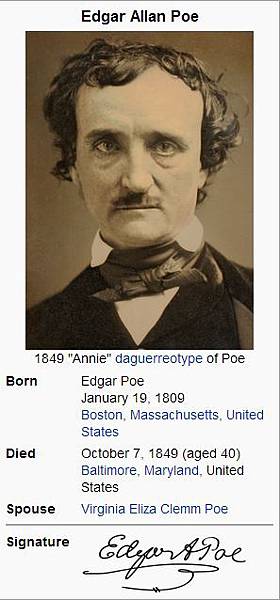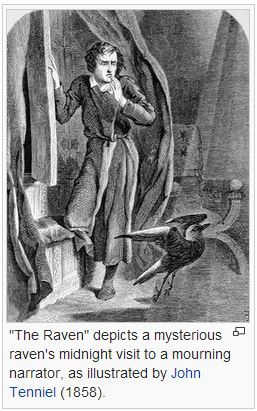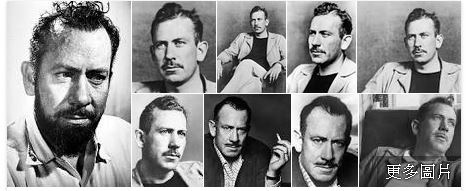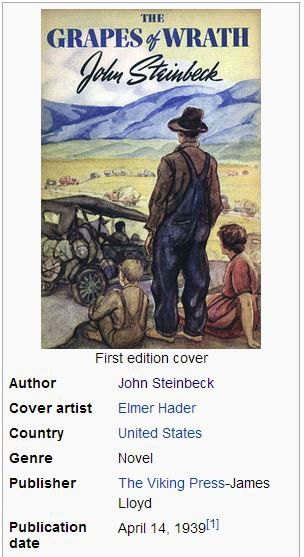現在美國問題:unemployment


CF commercial
在日本,電視廣告被稱為「CM」,是「commercial message」(コマーシャルメッセージ)的簡稱,原本是指「商業用的訊息」,並沒有特別限定是在電視上播出的。但在電視和廣播的普及之下,漸漸成為電視廣告的專用名詞。而廣義的「CM」則是包含電視、電影、網路上的廣告影片,需要區別的時候,則改稱「CF」(commercial film)。
電視廣告的英文在美國為「television commercial」,而在英國則為「advert」。
 老師分享:商周
老師分享:商周
是自己不長進,還是資源分配不公平?》史丹佛大學把課程免費上網,結果沒人要用

Edgar Allan Poe (/poʊ/; born Edgar Poe; January 19, 1809 – October 7, 1849) was an American author, poet, editor, andliterary critic, considered part of the American Romantic Movement. Best known for his tales of mystery and the macabre, Poe was one of the earliest American practitioners of the short story, and is generally considered the inventor of thedetective fiction genre. He is further credited with contributing to the emerging genre of science fiction.[1] He was the first well-known American writer to try to earn a living through writing alone, resulting in a financially difficult life and career.[2]
Born in Boston, Poe was the second child of two actors. His father abandoned the family in 1810, and his mother died the following year. Thus orphaned, the child was taken in by John and Frances Allan, of Richmond, Virginia. Although they never formally adopted him, Poe was with them well into young adulthood. Tension developed later as John Allan and Edgar repeatedly clashed over debts, including those incurred by gambling, and the cost of secondary education for the young man. Poe attended the University of Virginia for one semester but left due to lack of money. Poe quarreled with Allan over the funds for his education and enlisted in the Army in 1827 under an assumed name. It was at this time his publishing career began, albeit humbly, with an anonymous collection of poems, Tamerlane and Other Poems (1827), credited only to "a Bostonian". With the death of Frances Allan in 1829, Poe and Allan reached a temporary rapprochement. Later failing as an officer's cadet at West Point and declaring a firm wish to be a poet and writer, Poe parted ways with John Allan.
最有名作品:
The tell-tale Heart
 他的幻覺是那位被他殺死的老人的心臟仍然在地板下跳動
他的幻覺是那位被他殺死的老人的心臟仍然在地板下跳動
 《泄密的心》被普遍認為是一篇經典的哥德小說作品,也是愛倫·坡的最有名的短篇故事之一。
《泄密的心》被普遍認為是一篇經典的哥德小說作品,也是愛倫·坡的最有名的短篇故事之一。
The Raven 烏鴉--攻其不備的球隊以此文學命名<Baltimore Ravens>

 -->在網頁中圖方下方可以線上聽全文
-->在網頁中圖方下方可以線上聽全文
"The Raven" is a narrative poem by American writer Edgar Allan Poe. First published in January 1845, the poem is often noted for its musicality, stylized language, and supernatural atmosphere. It tells of a talking raven's mysterious visit to a distraught lover, tracing the man's slow fall into madness. The lover, often identified as being a student,[1][2] is lamenting the loss of his love, Lenore. Sitting on a bust of Pallas, the raven seems to further instigate his distress with its constant repetition of the word "Nevermore". The poem makes use of a number of folk and classical references.
Poe claimed to have written the poem very logically and methodically, intending to create a poem that would appeal to both critical and popular tastes, as he explained in his 1846 follow-up essay "The Philosophy of Composition". The poem was inspired in part by a talking raven in the novel Barnaby Rudge: A Tale of the Riots of 'Eighty by Charles Dickens.[3] Poe borrows the complex rhythm and meter of Elizabeth Barrett's poem "Lady Geraldine's Courtship", and makes use of internal rhyme as well as alliteration throughout.
"The Raven" was first attributed to Poe in print in the New York Evening Mirror on January 29, 1845. Its publication made Poe widely popular in his lifetime, although it did not bring him much financial success. Soon reprinted, parodied, and illustrated, critical opinion is divided as to the poem's status, but it nevertheless remains one of the most famous poems ever written.[4]
<Baltimore Ravens> 點連結可以到官網

The Baltimore Ravens are a professional American football team based in Baltimore, Maryland, playing in the North Division of the American Football Conference (AFC) in the National Football League (NFL). The team has played its home games at M&T Bank Stadium in downtown Baltimore since 1998, and is headquartered at the Under Armour Performance Center in Owings Mills.[2]
John Steinbeck--最有名作品<The Grapes of wrath>《憤怒的葡萄》

"Steinbeck" redirects here. For other people with this surname, see Steinbeck (surname).
John Ernst Steinbeck, Jr. (February 27, 1902 – December 20, 1968) was an American author of twenty-seven books, including sixteen novels, six non-fiction books, and five collections of short stories. He is widely known for the comic novels Tortilla Flat (1935) and Cannery Row (1945), the multi-generation epic East of Eden (1952), and the novellas Of Mice and Men (1937) and The Red Pony (1937). The Pulitzer Prize-winning The Grapes of Wrath (1939), widely attributed to be part of the American literary canon,[2] is considered Steinbeck's masterpiece. In the first 75 years since it was published, it sold 14 million copies.[3]
The winner of the 1962 Nobel Prize in Literature, he has been called "a Giant of American letters".[4] His works are widely read abroad and many of his works are considered classics of Western literature. His leftist political tendencies and the relatively provincial setting of his works has made him a very polarizing writer, both in the United States and in international literary circles. Until recently, the mandated teaching of his works in the British educational system has been controversial.
Most of Steinbeck's work is set in southern and central California, particularly in the Salinas Valley and the California Coast Ranges region. His works frequently explored the themes of fate and injustice, especially as applied to downtrodden oreveryman protagonists.

The Grapes of Wrath is an American realist novel written by John Steinbeck and published in 1939. The book won theNational Book Award[2] and Pulitzer Prize[3] for fiction, and it was cited prominently when Steinbeck was awarded theNobel Prize in 1962.[4]
Set during the Great Depression, the novel focuses on the Joads, a poor family of tenant farmers driven from theirOklahoma home by drought, economic hardship, agricultural industry changes and bank foreclosures forcing tenant farmers out of work. Due to their nearly hopeless situation, and in part because they were trapped in the Dust Bowl, the Joads set out for California. Along with thousands of other "Okies", they sought jobs, land, dignity, and a future.
The Grapes of Wrath is frequently read in American high school and college literature classes due to its historical context and enduring legacy.[5][6][7] A celebrated Hollywood film version, starring Henry Fonda and directed by John Ford, was made in 1940.
bouleloud簡稱BLD
The romantic period of England 有五位名人:
 Ode to the west wind(最後一句最有名)---Trumpet of a prophecy shelley
Ode to the west wind(最後一句最有名)---Trumpet of a prophecy shelley
The "trumpet of prophecy" is a critical component of Shelley's closing in "Ode to the West Wind." He seeks to link the natural phenomena of storms and the natural changing of the seasons to the his own hopes of achieving poetic immortality from obscurity. Essentially, through a natural experience, Shelley seeks to link it to his own evolution as both thinker and artist. Shelley sees the power of the winds, as it scatters leaves and hopes that it will "drive my dead thoughts over the universe," an allusion to the fact that while he might not be appreciated now, Shelley hopes to achieve poetic immortality over time. As "ashes and sparks" are scattered, his hopes are that his worlds will follow accordingly. He closes the poem with the idea that the "trumpet of a prophecy" is the wind, and its signal for change, for growth, for evolution. As the seasons change, from winter to spring, his hopes are that his measure as a poet and thinker will also evolve, and the trumpet is the natural evolution from destruction to creation. The prophecy aspect makes this as something known and understood, what he seeks for both his words and stature as a poet.
I Wandered Lonely as a Cloud - Wordsworth, William.
"I WANDERED LONELY AS A CLOUD"
I WANDERED lonely as a cloud That floats on high o'er vales and hills, When all at once I saw a crowd, A host, of golden daffodils; Beside the lake, beneath the trees, Fluttering and dancing in the breeze. Continuous as the stars that shine And twinkle on the milky way, They stretched in never-ending line Along the margin of a bay: 10 Ten thousand saw I at a glance, Tossing their heads in sprightly dance. The waves beside them danced; but they Out-did the sparkling waves in glee: A poet could not but be gay, In such a jocund company: I gazed--and gazed--but little thought What wealth the show to me had brought: For oft, when on my couch I lie In vacant or in pensive mood, 20 They flash upon that inward eye Which is the bliss of solitude; And then my heart with pleasure fills, And dances with the daffodils.
會考ID喔:Ballad 民歌, 歌謠, 敘事歌, 流行歌曲, 情歌
A ballad /ˈbæləd/ is a form of verse, often a narrative set to music. Ballads derive from the medieval French chanson balladéeor ballade, which were originally "dancing songs". Ballads were particularly characteristic of the popular poetry and song of the British Isles from the later medieval period until the 19th century and used extensively across Europe and later the Americas,Australia and North Africa. Many ballads were written and sold as single sheet broadsides. The form was often used by poetsand composers from the 18th century onwards to produce lyrical ballads. In the later 19th century the term took on the meaning of a slow form of popular love song and is now often used for any love song, particularly the pop or rock power ballad.
usher領路人(課本p.702)
- n.
- (戏院、教堂等公共场所的)引座员;招待员
- (法院等处的)门房,传达员
- (给贵宾)领路人;先导人员
- (婚礼上的)迎宾员
- [英国古语]助理教员
- vt.
- 引導,带领;招待;陪同:
VOC:
1. rational---rational thoughts, decisions etc are based on reasons rather than emotions
例:Parents need to be fully informed so they can make a rational decision.
2. sepulchre British English ; sepulcher American English
---a small room or building in which the bodies of dead people were put
uterus plural uteruses [countable]